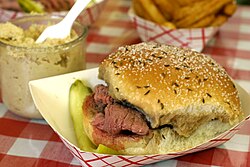
Horseradish is a perennial plant of the family Brassicaceae. It is a root vegetable, cultivated and used worldwide as a spice and as a condiment. The species is probably native to southeastern Europe and western Asia.
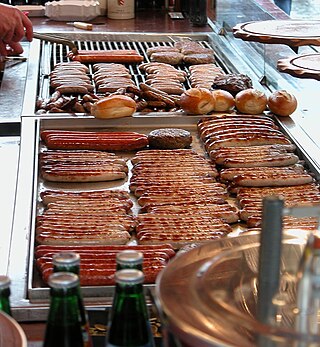
Bratwurst is a type of German sausage made from pork or, less commonly, beef or veal. The name is derived from the Old High German Brätwurst, from brät-, finely chopped meat, and Wurst, sausage, although in modern German it is often associated with the verb braten, to pan fry or roast. Beef and veal are usually incorporated amongst a blend often including pork.
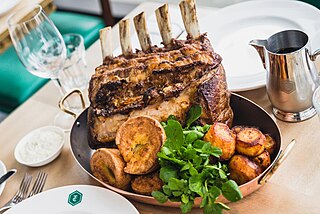
Roast beef is a dish of beef that is roasted, generally served as the main dish of a meal. In the Anglosphere, roast beef is one of the meats often served at Sunday lunch or dinner. Yorkshire pudding is a standard side dish. Sliced roast beef is also sold as a cold cut, and used as a sandwich filling. Leftover roast beef may be minced and made into hash.

Arby's is an American fast food sandwich restaurant chain with more than 3,300 restaurants system wide and third in terms of revenue. In October 2017, Food & Wine called Arby's "America's second largest sandwich chain ".
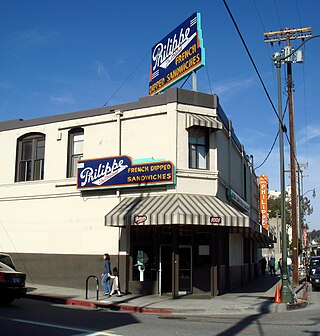
Philippe's, or "Philippe the Original" is a restaurant located in downtown Los Angeles, California. The restaurant is well known for continuously operating since 1908, making it one of the oldest restaurants in Los Angeles. It is also renowned for claiming to be the inventor of the French dip sandwich.

A French dip sandwich, also known as a beef dip, is a hot sandwich consisting of thinly sliced roast beef on a "French roll" or baguette. It is usually served plain but a variation is to top with Swiss cheese, onions, and a dipping container of beef broth produced from the cooking process. Beef stock, a light beef gravy, or beef consommé is sometimes substituted. The sandwich is an American invention, with the name seeming to refer to the style of bread, rather than any French origin. Although the sandwich is most commonly served with a cup of jus or broth on the side of the plate, into which the sandwich is dipped as it is eaten, this is not how the sandwich was served when it was invented.

Rémoulade is a cold sauce. Although similar to tartar sauce, it is often more yellowish, sometimes flavored with curry, and often contains chopped pickles or piccalilli. It can also contain horseradish, paprika, anchovies, capers and a host of other items.
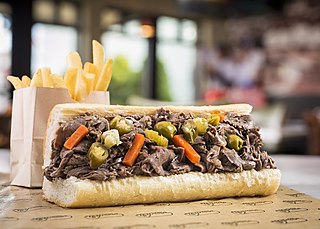
An Italian beef sandwich, originating in Chicago, is composed of thin slices of seasoned roast beef, simmered and served au jus on a long French roll. The sandwich's history dates back at least to the 1930s. The bread itself is, at the diner's preference, often dipped into the juice the meat is cooked in, and the sandwich is typically topped off with Chicago-style giardiniera or sauteed, with green Italian sweet peppers.

The Kaiser roll, also called a Vienna roll, kajzerka or a hard roll, is a typically crusty round bread roll, originally from Austria. It is made from white flour, yeast, malt, water and salt, with the top side usually divided in a symmetric pattern of five segments, separated by curved superficial cuts radiating from the centre outward or folded in a series of overlapping lobes resembling a crown. The crisp Kaisersemmel is a traditional Austrian food officially approved by the Federal Ministry of Agriculture.
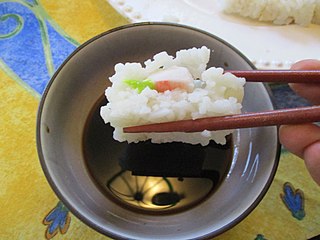
A dip or dipping sauce is a common condiment for many types of food. Dips are used to add flavor or texture to a food, such as pita bread, dumplings, crackers, chopped raw vegetables, fruits, seafood, cubed pieces of meat and cheese, potato chips, tortilla chips, falafel, and sometimes even whole sandwiches in the case of jus. Unlike other sauces, instead of applying the sauce to the food, the food is typically placed or dipped into the sauce.
Sandwiches That You Will Like is a 2002 PBS documentary by Rick Sebak of WQED. The unique sandwich offerings of cities across the United States are shown, from those that are often found outside of their city of origin to the virtually unknown.

Hofbrau is a cafeteria-style food service derived from the German term Hofbräu, which originally referred to a brewery with historical ties to a royal court. Such breweries often have beer gardens where food is served.

Beef tongue is a cut of beef made of the tongue of a cow. It can be boiled, pickled, roasted or braised in sauce. It is found in many national cuisines, and is used for taco fillings in Mexico and for open-faced sandwiches in the United States. In France and Belgium it is served with Madeira sauce, while chrain is the preferred accompaniment in Ashkenazi and Eastern European cuisines. Germans make white roux with vinegar and capers, or horseradish cream, which is also popular in Polish cuisine.

A steak sandwich is a sandwich prepared with steak that has been broiled, fried, grilled, barbecued or seared using steel grates or gridirons, then served on bread or a roll. Steak sandwiches are sometimes served with toppings of cheese, onions, mushrooms, peppers, tomatoes, and in some instances fried eggs, coleslaw, and french fries.

Pit beef is a dish of roast beef prepared over a charcoal fire, commonly using top round cuts of beef. The cooked roast is sliced thinly and often served on a Kaiser roll, accompanied by tiger sauce and sliced raw onion. Unlike barbecue, the meat is cooked quickly at high temperatures, served rare, and has a light smoke flavor.
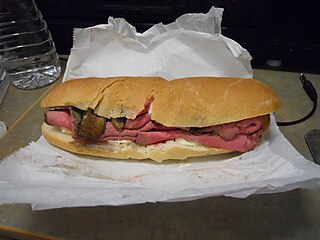
The roast beef sandwich is a sandwich that is made out of sliced roast beef or sometimes beef loaf. It is sold at many diners in the United States, as well as fast food chains, such as Arby's, Rax Roast Beef, and Roy Rogers Restaurants. This style of sandwich often comes on a hamburger bun and may be topped with barbecue sauce and/or melted American cheese. The roast beef sandwich also commonly comprises bread, cold roast beef, lettuce, tomatoes, and mustard, although it would not be uncommon to find cheese, horseradish, fresh/powdered chili pepper and even in some cases red onion. Roast beef sandwiches may be served hot or cold, and are sometimes served open faced.

Pastrami on rye is a sandwich that was popularized in the Jewish kosher delicatessens of New York City. It was first created in 1888 by Sussman Volk, who served it at his deli on Delancey Street in New York City.
Brennan & Carr is a roast beef sandwich shop in Sheepshead Bay, Brooklyn open since 1938. It appeared on Man v. Food.
